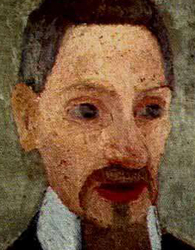Rainer Maria Rilke spent his life traveling the globe. Despite a variety of lovers and locales—Prague, Munich, Rome, Paris and Switzerland—Rilke remained alone, seeking a level of self-knowledge that only solitude and introspection could offer him. Although he wrote several volumes of poetry, he is best known for a series of letters written in his later years and published as “Letters to a Young Poet.”
Rainer Maria Rilke’s Early Days
René Karl Wilhelm Johann Joseph Maria Rilke was born in Prague on December 4, 1875. Rilke’s father, Josef, was a former army officer who failed to obtain a commission after years of service. Rilke’s mother Sophie (known as Phia) was 13 years younger than her husband. Initially swayed by Josef’s family heritage, Phia eventually grew disenchanted with his inability to rise in a social or professional hierarchy, which caused the relationship to sour.
The couple’s first child died shortly after birth, and Phia was deeply scarred by the loss of the daughter. When her son was born a year later, Phia gave him the names “René” and “Maria” in an effort to bestow upon him some feminine identity. In fact, until he was five years old, Rilke was dressed in girls’ clothing. Rilke’s father, eager for the boy to join the military, sent his son to the academies of St. Pölten and Mährisch-Weisskirchen for five years, from 1886–1891.
Sources in this Story
- The Washington Post: Life of a Poet: Rainer Maria Rilke
- Bookrags: Rainer Maria Rilke
- Poets.org: Rainer Maria Rilke
- The Atlantic: To work is to live without dying
- Time magazine: Santa Claus of Loneliness
Rilke’s Notable Accomplishments
After leaving the military academy and spending some time at a German preparatory school, Rilke studied literature for a year at Charles University in Prague. By that time, his path was clear: he had already published his first volume of poetry, “Leben und Lieder” (“Life and Songs”) a year before. In 1896, Rilke published two other collections: “Larenopfer” (“Sacrifice to the Lares”) and “Traumgekrönt” (“Dream-Crowned”).
Following the publication of these works, Rilke began a life of travel, making his way to Germany, Italy and Russia, where he became acquainted with Leo Tolstoy. In Paris, he worked as a secretary for sculptor Auguste Rodin. It was during his time in France that Rilke published his first major works, beginning in 1906 with “Das Stunden Buch” (“The Book of Hours”), followed in 1907 by “Neue Gedichte” (“New Poems”) and “Die Aufzeichnungen des Malte Laurids Brigge” (“The Notebooks of Malte Laurids Brigge”).
Rilke spent his life traveling and had a variety of love affairs, most notably with the poet Lou Andreas-Salomé and sculptress Clara Westhoff, whom he wed but soon left. Rilke was unable to stay in one place; the tension between his love of travel and love of women inspired him to become one of the most magnificent letter writers of his era. In fact, it is for the series of correspondences he wrote to an aspiring poet—“Letters to a Young Poet”—that Rilke is best known.
The Man and his Work
- The Selected Poetry of Rainer Maria Rilke
- Rilke on Love and Other Difficulties
- Duino Elegies and the Sonnets of Orpheus
- Letters to a Young Poet
- Life of a Poet: Rainer Maria Rilke by Ralph Freedman
The Rest of the Story
Despite his travels and romantic intimacies, Rilke’s life was marked by loneliness. One of Rilke’s mentors, the French writer Paul Valéry, described the poet as spending “eternal winters long in excessive intimacy with silence.” Rilke dedicated his life to pursuing “Weltinnenraum,” or “inner-world-space,” believing that only by deep introspection could one truly understand the mind. Rilke died of a rare form of leukemia on December 29, 1926; some of his last words were, “Life is a glory.”
This article was originally written by Isabel Cowles; it was updated December 5, 2017.











